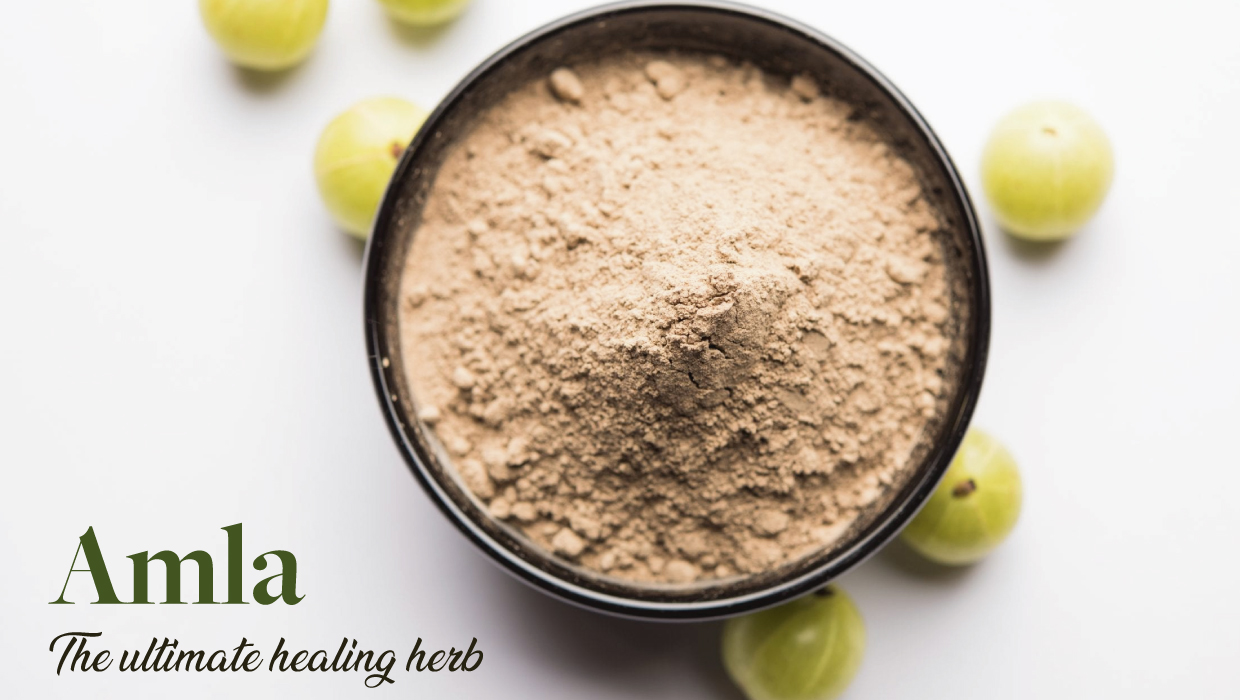Amla, also known as the Indian Gooseberry, is one of the most renowned natural remedies in the world, owing to its restorative and rejuvenating properties.
In Ayurveda, Amla is often referred to as “Dhatree”, which means mother or protector, or the one who takes care, for it takes care of the body and mind and helps keep the body free from any disease and disorder.
One fascinating characteristic of Amla is that it helps in the pacification of all the three doshas, the bioenergies Vata, Pitta, and Kapha, and thus maintains equilibrium in the body.
Amla is considered to be one of the best rejuvenators by the ancient classics, it acts on minute cellular levels and is one of the best anti-aging herbs available.
Locally, the application of Amla paste helps relieve burning sensation, pain, and inflammation. Amla juice is known to repair body cells and helps clear foggy vision and other eye disorders if instilled in the eyes.
A decoction of the Amla fruit works wonderfully in stopping the excess flow of blood, rapid healing of wounds, and prevents pus formation and sepsis.
Internally, Amla exhibits a wide variety of actions and some of the most significant ones have been mentioned below.

Amla, a rich source of Vit C and an antioxidant
Amla is an excellent anti-oxidant and a rich source of vitamin C. It strives to protect our cells against the free-radicles, thus proving its actions at the cellular levels. It also acts as a potent blood purifier and cleanser.
Amla helps balance the body’s pH and clears obstructions and impurities in the gastrointestinal tract and other channels of the body, Ayurvedically known as Strotas.
Vitamin C present in the herb stimulates the digestive system and maintains the body’s metabolism, which boosts the body’s immunity and ensures over-all well-being.
An amazing remedy for Digestive Disorders-
Amla is an excellent choice to reduce and balance Pitta, the bioenergy of heat and fire. Hence, for digestive disorders like hyper-acidity, gastritis, and stomach ulcers, juice of amla herb is strongly recommended to reduce the intensity of the Symptoms.
The sugar present in amla fruit relieves headache, nausea, vomiting, and delirium. Amla, along with other medicinal herbs, is also used as a laxative in patients suffering from gas distension and chronic constipation.
The fruit revs up your digestive fire called Agni, and a well balanced biological fire is of immense importance for a healthy physical and mental state.
Read more about Agni, what it is and how to maintain balance, here.
Cooling action during Hot weather conditions-
Very often, people living in extremely warm regions or during the hot summer season, suffer from excessive heat in the body, which may lead to joint pain, raised body temperature, and fatigue. Amla juice is the perfect remedy in such conditions as it has the capacity to lower the body’s temperature up to a significant amount, thus making it an excellent summer drink.
Amla, A Gift To Your Skin-
Amla reduces the aggravated Pitta dosha in the body. According to Ayurveda, Pitta has a close association with the quality and quantity of blood.
Amla balances the level of Pitta Dosha, thereby ensuring the formation of pure blood, thus correcting symptoms of disorders related to impure blood formation and circulation, the simplest being various skin issues.
This helps in maintaining the tone and texture of the skin and heals pimples and dark spots. The herb, if used in the right dosage, can also cure long term skin disorders like psoriasis, eczema, dermatitis, etc.
Its positive effect on the reproductive system-
Known for its blood- purifying qualities, many menstrual disorders in women can be cured with the help of this herb.
Apart from that, it is known to give strength to the reproductive organs and reduce white discharge and painful cramps. Tedious and complicated cases of low sperm count and poor sperm quality can be corrected and cured with the help of this herb.
Amla as the ultimate rejuvenator
With respect to all the qualities of the herb mentioned above, the main therapeutic purpose of amla is for rejuvenation therapy.
Regular intake of this herb helps in the restoration and production of new cells, and thus maintains the state of youth.
It also prevents the degeneration of brain cells and prevents brain atrophy, often caused due to old age.
According to Charak Samhita(An ancient classical text of Ayurveda), Amla is by far the most therapeutic and powerful herb with great potency and has been used by the human race for many centuries.
Some important Ayurvedic formulations which contain Amla are Chyavanpraash avaleha, Dhatri avaleha and Brahmi Rasayana.
How to consume Amla every day?
Consuming Amla every day has benefits of its own. The results are so evident that you’ll be hooked to the practice of staying healthy with the help of this herb.
Easily available in various forms, Amla juice and powders, and amla candy are the easiest and hassle-free options to choose for everyday consumption.
For a healthy individual, consuming Amla early in the morning is the right way of including the fruit in your everyday schedule. Starting slow and small is the key. Do consult an Ayurvedic doctor before abruptly consuming it if you have any medical conditions.

Join us to read more of such articles and support our mission of mindful living for the modern world by subscribing to our blog and hitting us a follow on Instagram and Facebook @sarvedalife.

